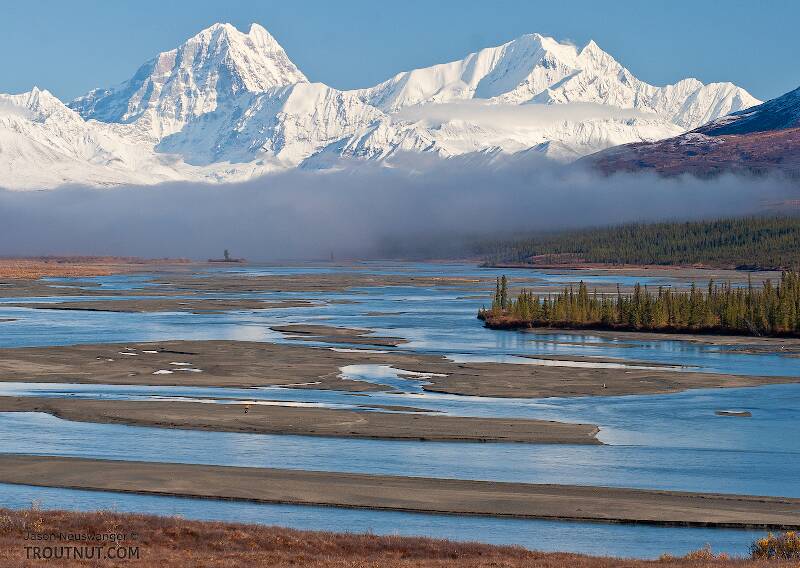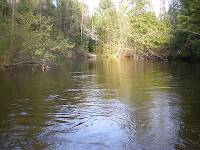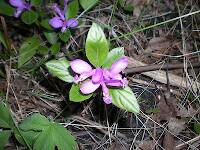
Blue-winged Olives
Baetis
Tiny Baetis mayflies are perhaps the most commonly encountered and imitated by anglers on all American trout streams due to their great abundance, widespread distribution, and trout-friendly emergence habits.
Featured on the forum

This specimen appears to be of the same species as this one collected in the same spot two months earlier. The identification of both is tentative. This one suffered some physical damage before being photographed, too, so the colors aren't totally natural. I was mostly photographing it to test out some new camera setting idea, which worked really well for a couple of closeups.

Troutnut is a project started in 2003 by salmonid ecologist Jason "Troutnut" Neuswanger to help anglers and
fly tyers unabashedly embrace the entomological side of the sport. Learn more about Troutnut or
support the project for an enhanced experience here.
Jlw_5178 on Apr 22, 2010April 22nd, 2010, 6:34 am EDT
I was hoping someone could help me out..I got this fly from a department store in a dry fly multi-pack, but i cant find one like it online cause i dont know what its called. It is some peacock herl with a turn or two of brown hackle at the front and a piece of red yarn at the back. does anyone know what this best imitates and what the common name of this pattern is? thanks, Jody
Jlw_5178 on Apr 22, 2010April 22nd, 2010, 6:35 am EDT
i took a picture and will post if i can figure out how???
Jlw_5178 on Apr 22, 2010April 22nd, 2010, 7:00 am EDT
ok heres the pic at flikr.com copy and paste to your address bar
http://www.flickr.com/photos/14563723@N07/?saved=1
http://www.flickr.com/photos/14563723@N07/?saved=1
GONZO on Apr 22, 2010April 22nd, 2010, 7:14 am EDT
Jody,
Your fly is an old wet-fly pattern called the "Brown Hackle" (sometimes known as the "Brown Hackle Peacock"). The "Gray Hackle" is a similar fly tied with grizzly hackle. The red "tag" was variously tied with red hackle fibers, red wing-quill sections, or red wool. Like many of the older wet flies, it was not tied as an imitation of anything in particular.
Your fly is an old wet-fly pattern called the "Brown Hackle" (sometimes known as the "Brown Hackle Peacock"). The "Gray Hackle" is a similar fly tied with grizzly hackle. The red "tag" was variously tied with red hackle fibers, red wing-quill sections, or red wool. Like many of the older wet flies, it was not tied as an imitation of anything in particular.
Jlw_5178 on Apr 22, 2010April 22nd, 2010, 7:33 am EDT
i guess im mostly curious about this fly cause there is a really great caddis hatch every evening right now at the antietam creek where i generally go to. the hatch gets pretty heavy, off and on throughout the late afternoon untill sunset. i rarely do see any surface activity,
but id have to assume their feeding on the emergers like crazy.
do you think this fly is a descent caddis emerger? if I could ask another one, why do they use red yarn in some patterns? It must be effective though bc i was talking to someone at the lake nearby and he was taking rainbows on a fly he called the proffesor. it also had red yarn trailing behind it and he swore by that pattern. thanks so much for your help! jody
but id have to assume their feeding on the emergers like crazy.
do you think this fly is a descent caddis emerger? if I could ask another one, why do they use red yarn in some patterns? It must be effective though bc i was talking to someone at the lake nearby and he was taking rainbows on a fly he called the proffesor. it also had red yarn trailing behind it and he swore by that pattern. thanks so much for your help! jody
GONZO on Apr 22, 2010April 22nd, 2010, 7:57 am EDT
The red tag was a common feature of a number of "attractor" wet-fly patterns, including the Woolly Worm, Zulu, Montreal, Grizzly King, and the Professor. A general approach to covering many common caddisfly emergers might start with a selection of simple soft hackles in tan, yellow, green, black, and peacock bodies. If the caddisfly activity you are seeing is an emergence rather than egg-laying, you can determine which color to use by looking at the body color of a freshly emerged adult. (Many adult caddisflies will darken considerably as they "age" after emergence.)
Jlw_5178 on Apr 22, 2010April 22nd, 2010, 8:20 am EDT
your advice is greatly appreciated! thank you so much, im gonna do some experimenting with them soft hackles. jody
Quick Reply
Related Discussions
Topic
Replies
Last Reply
7
May 29, 2012
by Possumpoint
by Possumpoint
2
Sep 5, 2012
by Sayfu
by Sayfu
4
May 24, 2011
by Jmd123
by Jmd123
6
May 12, 2013
by Tigermidge
by Tigermidge




